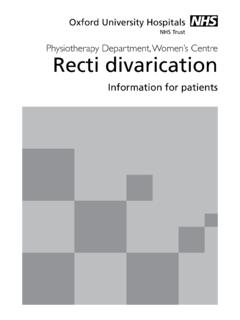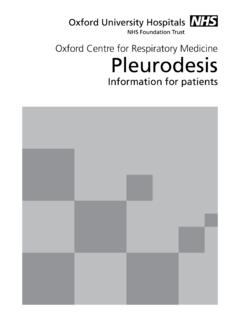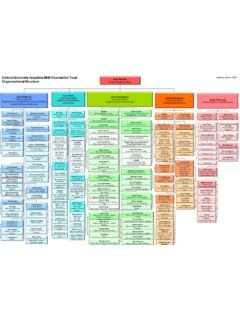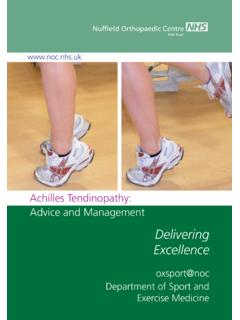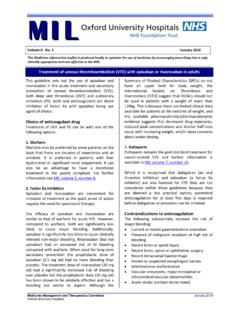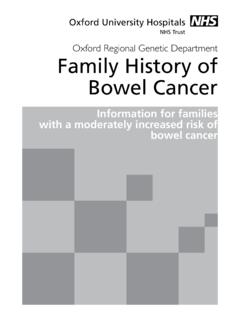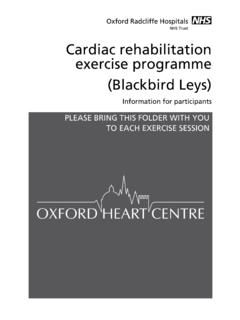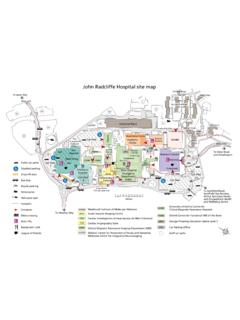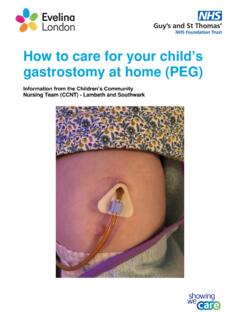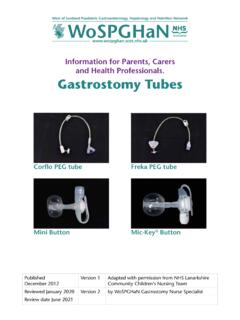Transcription of The Children’s Hospital Gastrostomy - ou h
1 The Children s HospitalGastrostomyInformation for parents and carerspage 2 What is a Gastrostomy ?A Gastrostomy is a tube which is inserted through the abdominal wall (tummy) into the stomach. There are two common types of Gastrostomy , Percutaneous Endoscopic Gastrostomy devices (PEGS) and low-profile Buttons .Why does my child need a Gastrostomy ?A Gastrostomy is usually needed if your child has feeding difficulties, for example, if they are unable to get the calories they require from feeding by mouth; if they have an unsafe swallow ; or if they have certain other medical conditions. page 3 Percutaneous Endoscopic Gastrostomy device(PEG) ( Corflo PEG, freka PEG)If your child is to have this type of Gastrostomy they will need to have an operation under general anaesthetic.
2 This means your child will be asleep throughout the PEG is placed into their stomach using an endoscope (narrow tube and camera), which is put in through your child s mouth. The PEG tube has a soft flange (piece of foam) on the inside of the stomach, to hold the PEG in place. It also has an external plastic bolster on the outside of your child s tummy, which holds the PEG in place and prevents it from travelling back into the type of Gastrostomy is usually the first choice of device, as it allows the stomach wall and abdominal wall to join together, while forming a channel (tract) for the child will need to come back into Hospital for another operation to change the PEG tube or fit a Button device. This will usually be after 6-12 months; to allow the Gastrostomy tract to heal.
3 Your surgeon will discuss this with you at your child s post-operative follow-up 4 Low-profile Button ( Mini Button, MIC-KEY, Medicina)The Button is a smaller device, which doesn t stick out as much from your child s tummy. It has a detachable extension set, which is used to give feed or Button is held in place by a small balloon filled with water which, when inflated, sits inside against the stomach wall. The outer part of the Button keeps the device secure on the outside of their water must be checked weekly to make sure the balloon is still inflated and not leaking. Your nurse will show you how this is done before your child is discharged home from Hospital . However, it will be checked the first few times by the Community Nurse or Complex Needs , a low-profile button without a balloon is used.
4 We will tell you if your child has one of 5 What are the risks?All operations carry some risks. There is a small risk of bleeding, infection and damage to nearby organs, such as the bowel. There is also the risk that the Gastrostomy tube might be inserted in an incorrect position, which may not be discovered until later on. Risks which may develop after the operation include: infection where the Gastrostomy tube has been put in movement of the tube (either out of position or further down into the stomach or bowel) blockage of the tube from food/milk or medicine leakage of stomach contents/feed around the Gastrostomy site, out onto the risksIn modern anaesthesia, serious problems are uncommon. Risk cannot be removed completely, but modern equipment, training and drugs have made general anaesthesia a much safer procedure in recent children recover quickly after their operation and anaesthetic.
5 Some children may suffer side effects like sickness or a sore throat. These usually last only a short time and there are medicines available to treat them if exact likelihood of complications depends on your child s medical condition and on the nature of the surgery and anaesthesia your child needs. The anaesthetist can talk to you about this in detail before the 6 ConsentThe doctor will explain the operation in more detail and talk with you about any concerns you may anaesthetist will also visit you to discuss the anaesthetic your child will have for the operation. They will also talk with you about the pain relief which your child will need after the will ask you for your written consent (agreement) for the operation to go ahead.
6 If there is anything you are unsure about, or if you have any questions, you can ask the doctor both before and after signing the consent assessmentYour child s named nurse will use a pain assessment tool to help assess their pain score after their operation. This is a chart which helps us to gauge how much pain your child may be feeling. You and your child will be introduced to this assessment tool either at their pre-assessment visit or on the ward before their operation. You can continue to use this assessment at home to help manage your child s pain if you statementAll girls aged 12 years and over will need to have a pregnancy test before their operation or procedure. This is in line with our Hospital policy. We need to make sure it is safe to proceed with the operation or procedure, because many treatments including anaesthetic, radiology (X-rays), surgery and some medicines carry a risk to an unborn child.
7 The pregnancy test is a simple urine test and the results are available immediately. If the result is positive we will discuss this and work out a plan to support your 7 Preparing for coming to hospitalYou will be given instructions which tell you how to prepare for your child s operation before they come to Hospital . Please make sure that you follow the fasting (starving) instructions which should be included with your child s appointment letter. Fasting is very important before an operation. If your child has anything in their stomach whilst they are under anaesthetic, it might come back up while they are unconscious and get into their lungs, with serious will also be given instructions on what to do about giving any medication that your child usually takes, whilst they are fasting before the operation.
8 Please make sure that you bring any medications that your child usually takes with you when you come into will happen on the day of the operation?Your child will be seen by an anaesthetic doctor, surgical doctor and a nurse, in preparation for the child is likely to be given medication (a phosphate enema) to clear their nurse and one parent/carer can go with your child to the anaesthetic room. Your child can also take a toy or may be possible to give the anaesthetic with your child sitting on your lap. Your child may either have anaesthetic gas to breathe or an injection through a cannula (a thin plastic tube that is placed under the skin, usually on the back of the hand). Local anaesthetic cream (EMLA or Ametop, sometimes known as magic cream ) can be placed on their hand or arm before injections so they do not hurt as much.
9 It works well for 9 out of 10 8If the anaesthetic is given by gas it will take a little while for your child to be anaesthetised. They may become restless as the gases take effect. If an injection is used, your child will normally become unconscious very quickly. Some parents may find this your child is asleep you will be asked to leave quickly so that the medical staff can concentrate on looking after them. The nurse will take you back to the ward to wait for your child will then be taken into the operating theatre to have the operation. The anaesthetist will be with them at all is the operation carried out?A narrow flexible tube called an endoscope , fitted with a tiny camera, will be gently passed through your child s mouth and into their stomach.
10 The surgeon will make a small incision (cut) on the outside of your child s tummy, through which they will fit the Gastrostomy . They will be able to see that the Gastrostomy is placed properly on the inside of the stomach, using the endoscopic incision on the outside of your child s tummy will heal around the Gastrostomy the Gastrostomy tube cannot be safely inserted using the endoscope. In this situation your child s surgeon may need to use a laparoscope for a clearer view. This will be inserted through another small cut on your child s , a larger cut will need to be made on the tummy (an open procedure). We will usually discuss this with you before the operation, if it is likely to need to be 9 After the operationYou will be able to go and see your child in the recovery room as soon as they are awake.
